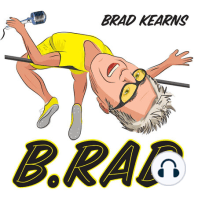15 min listen

MOFO Mission #9: Slow Down and Reclaim the Lost Art of Downtime (Breather Episode with Brad)
MOFO Mission #9: Slow Down and Reclaim the Lost Art of Downtime (Breather Episode with Brad)
ratings:
Length:
38 minutes
Released:
Oct 9, 2020
Format:
Podcast episode
Description
Learning how to really slow down and reclaim the lost art of down time is not just something you do for fun and enjoyment, but something that actually greatly affects the state of your health.Yes, taking time to socialize or to take an after-dinner stroll, making your easy workouts easier, and integrating temperature therapy and foam rolling are all effective activities to boostAssignments:1. Recovery-based training utilizes a different philosophy than ‘consistent’ miles or appearances at the gym. Use intuition and push when you are pumped, and back off when flat. Leave some juice in your tank at all times! Check out my show with Craig Marker to learn about HIIT vs HIRT and why going less hard = less cell destruction. Remember that muscle soreness is NOT a catalyst for growth. Protein synthesis goes to REPAIR instead of growth, so there is really no need to get sore.Take easier, easy days (like doing a positive deadlift on grass or some dynamic stretches). Increase daily movement as a form of recovery. JFW to increase blood circulation and lymphatic function.Introduce Rebound workouts. Validated by HRV to speed recovery, this includes: dynamic stretching, mobility/flexibility drills, foam rolling, and deep breathing exercises that boost blood circulation and oxygen delivery without stressing the body. 2. Brain down time from hyperconnectivityA meditation practice is ideal, or even exercising without a podcast or music!Set up a morning routine that you can stick to. 84% of people reach for the phone most mornings. Instead, walk the dog, gratitude journal, or do elaborate flexibility/mobility stretches or yoga.Set aside time for Deep Work periods where you disconnect. (Listen to my Breather show on Cal Newport). The brain gets more tired managing text and email all day! So focus, get it done, and flip the lid closed!3. Spend Time in NatureUniversity of Michigan professors, the Kaplans, promote their ‘attention restoration theory’ as a way of recovering from what they call “directed attention fatigue” of non-stop information bombardment of modern times promoting sympathetic dominance and eventually, crankiness and irritableness. Nature allows passive engagement of the senses (take it in), triggers a drop in cortisol, BP and HR. Neuroscience professor Michael Merzenich explains that, “Our attraction to the ocean may derive from its lack of physical markers…. Looking over a calm sea is akin to closing our eyes.” Kaplan’s call for engaging with nature fascination is that, the more grand and spectacular the setting, the greater the fascination. Think: Yosemite, Niagara falls, The Grand Canyon, sailing in the ocean, or simply swimming in Tahoe. Any kind of nature is great; even imagery has been to have effect. Invest in a mini fountain, or get a poster/change your screensaver to a nature based image you’re drawn to.4. NappingA 20 minute nap refreshes sodium and potassium pumps in your brain neurons, allowing you to go from literally feeling fried (because the electrical circuitry is depleted) to re-energized.I’m pro napper through training. I turn on App Rainmaker Pro and I’m gone. I find a quiet or sunny spot, disengage; it’s a ritual. Many say they ‘can’t nap’ but that’s likely because of the environment. Dr. David Dinges, a sleep expert at University of Pennsylvania Medical School whose laboratory studies how sleep affects neurobehavioral, cognitive, immune, inflammatory, endocrine, metabolic, and genetic function, estimates that 15-20 percent of the population are highly sensitive, calling them “closet nappers.” Dr. Sara Mednick, a Harvard-trained psychologist currently studying sleep at UC Riverside, and author of Take A Nap, Change Your Life, estimates that up to 50% of the population is genetically predisposed to napping. If you struggle with napping, go easy on yourself: to start, at first, just disengage, go quiet (even to your car or park bench) and rest your head (the key element of a proper nap), even if you don’t fall asl
Released:
Oct 9, 2020
Format:
Podcast episode
Titles in the series (100)
Relationship Advice Tidbits (Breather Episode with Brad) by The B.rad Podcast